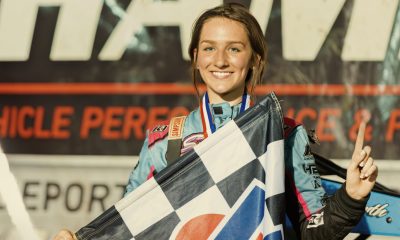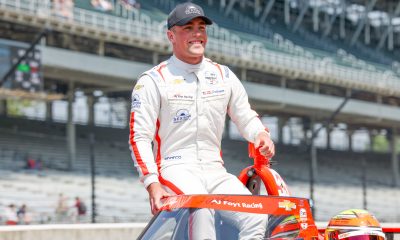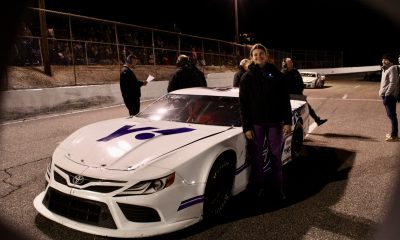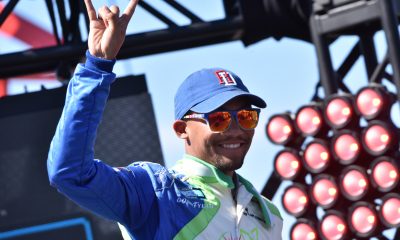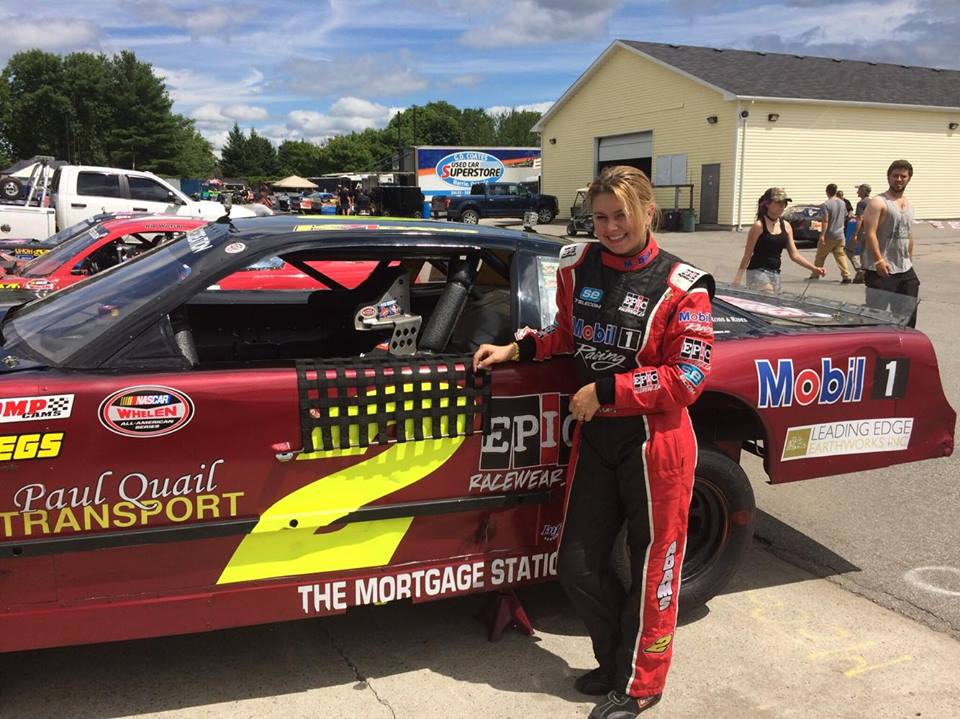
While 2016 may have been an eventful year in the history books, for 17-year-old Kendra Adams of Ontario, Canada, it was a year to remember filled with gains at and off the track for this young racer. In many ways, Adams grew up while also flourishing as a solid super stock racer at Sunset Speedway, her local hometown track.
Last July, we introduced Adams and her motorsports story, getting acquainted with this down to earth racer. Her father Brendan had competed in late model races and to say the least, the racing bug bit young Kendra immediately. With some convincing from her mother Kelly, this young gun’s journey in the sport started when she turned 13 years old.
Over the years, Adams has gained valuable experience at her local short track, gaining the respect of her competitors, finding the balance between patience and aggression, and most of all, finding her confidence in her abilities and path in this competitive sport. Make no mistake that this isn’t a hobby of hers and not a journey to become the top female racing talent.
Along the way, Adams is evolving as a person and a racer. She understands and respects that she’s working towards a path in this sport that only few get to even realize, or much less consider. Suffice to say, she appreciates this sport, the history that comes with it, and is willing to work hard to realize her dreams as she progresses forward from her humble beginnings.
Instead, Adams wants to forge her path as a diligent, tenacious, and savvy racer, taking some inspiration from the late Alan Kulwicki. If there’s anyone in racing who’s shown that there’s more than one way to excel in motorsports, it’s the 1992 Monster Energy NASCAR Cup Series champion.
Adams is the total package in terms of understanding the give and take nature of racing, whether it’s in that driver’s seat or with the obligations of the media. There’s a great sense of candor, maturity, and thoughtfulness that comes with this talented racer as she prepares for the 2017 racing season.
If 2016 was a prelude to Adams’ promising breakthrough moment, then this will be a year to watch this Canadian racer thrive as she carves her path into NASCAR racing. While most of us are thawing out from the cold winter, let’s try to start our TPF racecar up by “Getting On Track with Kendra Adams!”
Rob Tiongson : 2016 was quite the productive year for you and your family run team. What were some of the valuable lessons you can take away from on and off track experiences that will be beneficial for you heading into 2017?

Be your own competitor. (Photo Credit: Mobil 1 The Grid TV)
Kendra Adams : Never to compare myself to anyone else. I’m in the early stages of my racing still and frequently compared myself to those racing for years. That shakes your confidence in yourself and can be your own worst enemy. I try to race by trying to do better than I did last race, to beat my own expectations of myself. Also, to never let anyone destroy your confidence. Confidence is key in racing and I am still trying to be confident in myself. It’s been one of the most frequent constructive criticisms I’ve heard about myself.
RT : In a way, it’s pretty interesting how life and racing coalesce. In some ways, would you say you’re growing up as a person and a racer while balancing your life away from the track?
KA : For sure! I started racing at 13 so who I am today is heavily influenced by racing and the lessons I have learned there. I grew up basically with sponsorship commitments and representing these companies. I had to make sure I grew up to be the person they would want and respect as a brand ambassador. Because of that, many decisions I make as a teen are always in the best interest for me as a person and the best interest of my sponsors. I think, overall, this has helped me to become a better, more compassionate person.
RT : It sounds like you’re on the right track especially in a sport where it can be very competitive and character building. For this coming season, what’s some of your goals at the track(s) you’ll be competing at this season? Eyeing towards a path in the States with NASCAR?
KA : To be honest, we haven’t finalized our 2017 plans. I have two cars, my super stock I raced last year, and the limited late model I bought at the end of 2016. What I know so far is that I will race my super stock full time and do a lot of practicing in the limited late model and probably share the car with my Dad and let him race it a few nights.
I’ll be racing at Sunset Speedway for the NWAAS points. I do race on a budget so funding for this year will determine what we will do in 2017.
We just announced last week that Mobil 1 will be my primary sponsor for 2017. We’ll have another press release this week with some more exciting news as well.
As for racing in the USA, that would be a dream. I am just finishing high school in a couple of weeks and then will be attending college in the fall, not sure where yet. For me to race in the States, it would be a big financial commitment and I would have to move there. So although that would be amazing, I don’t have that funding or a crew that could make the move with me.
RT : The path and plan you’ve got reminds me a lot of a great legendary racer named Alan Kulwicki. Is education something you’re definitely pursuing as a fallback with racing and to also gain more skill set with the way our sport is evolving?
KA : Interesting that you say that. Much like Alan Kulwicki, I started racing late in life compared to a many. He had a passion to succeed and brought into racing some skill sets not widely used at the time. With his background in engineering and his approach, he changed the way NASCAR would move in the future. Alan Kulwicki was considered an underdog when he moved into NASCAR and showed the world that the underdog shouldn’t be taken for granted. I look forward to the day when I can show people that, as the underdog, I shouldn’t be taken for granted either.
I would love to have great success in racing, but I do have to move forward with a realistic approach. Much like any professional sport, you have to have a back up plan. Truthfully, schooling and furthering my career ambitions are not my back up plan, but my primary plan. To make it in racing today, you need extreme talent, financial backing and the ability to attract top class sponsors and represent them well. In Canada, we don’t have the same racing opportunities as those in the USA. I would need to move there to have a chance at a career, and I do plan to move there someday, but to race there is likely something out of my reach at this time. Regardless, I will continue to take racing as far as I can and be as involved in it as I can for my future.
I’ve learned through racing that I am actually pretty good at marketing and promotions and have decided to make this my future and this is what I will attend college to study. Hopefully, I’ll work for NASCAR or a race team in the future.
RT : Many professionals like Kelley Earnhardt Miller and Mike Joy have found a future in the route you just described. Who are some people you’d say have helped you with building your connections in the world of NASCAR?

Adams has definitely learned to appreciate her role as an ambassador for her sponsors. (Photo Credit: Jerry Abramowicz)
KA : I’ve made some amazing contacts through a variety of different ways. Being selected to compete in the NASCAR Drive for Diversity program allowed me to meet some great people. Through my sponsors, Mobil 1 and Epic Racewear, I’ve been connected with others and had some amazing experiences because of that as well as some friends I have met in the NASCAR community. Through my social media, I’ve made some connections as well. I think many people don’t appreciate the power of social media.
As with any business, making connections is important.
RT : It absolutely is, just as it is to know the nuances of the cars and tracks. For a driver who’s young and still climbing up the racing ladder, you definitely possess the qualities of a leader. Would you say it’s something innate with you having grown up in a family with racers?
KA : I really wasn’t a leader in the beginning. When I first started I was young and it was all new to me, from the drivers side. My dad stopped racing when I was 4 or 5. When I started racing, my parents bought me my car and said I had to find my own sponsorship, that was my job. At 13, that was a little overwhelming for me. It took confidence I didn’t have at that time to just go up and ask people to sponsor me. But it helped me to gain confidence in myself and to learn to speak in a professional manner, to ask people to believe in me and help me fulfill my dreams.
I approached a wonderful couple, Dave and Pam, owners of Twin Contracting to see if they would sponsor me my first season. They agreed to be my primary sponsor and stayed with me for two years. One of my Dad’s sponsors from years ago, Paul Quail Transport, came on board to sponsor me as well and still remain as my longest running supporter. With them supporting me, this was really a turning point for me.
As time went on, and I gained confidence and grew more comfortable with talking to people, it became easier for me to develop the relationships needed to attract and maintain sponsors.
I looked up to all the older people who had raced a long time and again, as a young person, it took a lot for me to make friends. I used to be extremely shy so this really helped me as well.
Today, yes, I would say that racing has turned me into a leader. The confidence I have gained as a person, both personally and in business, I have come so far from the 13-year-old me.
I would help anyone that asked for it, for advice in racing, social media presentation and marketing themselves. I’ve had a number of people ask how I attract sponsors and what they need to do and I try to help them in anyway that I can.
RT : I think that’s what’s so important with the cycle of racing. Helping one another is what fuels this sport for its longevity. That said, what’s perhaps some of the most important qualities that makes a good racer have a career that lasts for a long time in our sport?

Adams’ journey in this sport wouldn’t go far without the support of her sponsor and fans. (Photo Credit: Kendra Adams Motorsports)
KA : In all levels of racing, the fans are what make the sport. Without the fans, none of us can do what we love. So I believe some of the most important qualities are to be respectful of the fans and the track that you represent. Along with that, you have to give back to your sponsors. Too many people believe that once they receive the sponsor check, they only have to put the decal on the car and it ends there. Because of this, too many business owners don’t want to become involved. Sponsors are the backbone of our sport and we have to make sure we develop good relations with them and make sure we are promoting them and being the best brand ambassador for them, both on and off the track.
RT : Absolutely, the sport is fueled by its fans. They pretty much can influence the direction of things. If there’s perhaps a few things you could change about racing to make it more accessible and affordable, what aspects would you look into?
KA : On a local racing level, in a lot of cases, the racers are their own worst enemy. A lot of times, racers want more and more to improve their cars and make them faster. This drives up the cost and can really separate the field. The tracks are good with locking in the rules for an extended time and attempting to control costs with things like tire rules. But honestly, those with the money will just find other ways to improve their cars. Money not spent on tires will be used elsewhere.
We look at racing as a hobby and our entertainment. We race within a set budget and if that means we run mid pack, that’s okay. I don’t want my parents to go into debt so I can have the chance to win races or run consistently up front.
With accessibility in our local level, we need to keep the beginner class as a beginner class. Keep the costs low while keeping safety a priority. If the beginner class is affordable, we can bring more people into the sport. A big problem in the beginner class is having $3,000 cars trying to compete with $15,000 cars. If racers just starting out don’t feel competitive, or are getting lapped over and over, they will get frustrated and probably end their career there. We want them to love the sport and in order to do that, we have to give them a reason to love racing so they can eventually decide that is were they want the invest their money and move up the rough the ranks.
RT: Easing up on the transition and certainly making sure it’s financially reasonable could certainly ease the burden on racing families, thus ensuring the longevity of our sport. Before we get to the last question, let’s have some fun with Free Association. Tell me the first thing that comes to mind with the select words, starting with the following:
Tradition.
KA : Family hobbies.
RT : Superstition.
KA : Never say rain on race day.
RT : Trailblazer.
KA : Alan Kulwicki – set goal and attain them.
RT : Rivalries.
KA : Try to avoid them.
RT : Favorite go to song to get pumped up for a race.
KA : “Steve McQueen” by Sheryl Crow.
RT : If you could pick any actress to play you in a biopic of your life, it would be…
KA : Selena Gomez.
RT : When a fan tells you that you’re their inspiration, how humbling is it to hear that especially when you’re working hard on realizing your dreams?

Watch for the unmistakable No. 2 late model piloted by Adams on the track! (Photo Credit: Debbie-Jo Zardo)
KA : Honestly, that is the most rewarding thing ever. To hear a fan say that, to look up to me, is so amazing. I know what it feels like to look up to someone – like Joey Logano, Tony Stewart, Jeff Gordon, the list goes on and on – so to have some young fan look up to me makes everything so worthwhile. I know what it feels like to get just a few moments with those that I look up to, I want to give that back. To know that I might make a difference to someone, to know that they will feel that they to can do anything they set their mind to, that makes me feel good about everything I do.
I have a lot of support from so many people and because of that, I choose to give back to others as well. I decided at the end of 2015 to support Laps for Muscular Dystrophy, raising funds and awareness. In 2016, I began working with the Kids Help Phone. Through my sponsor, SE Telecom, they hosted a charity BBQ and through other fund raising events as well, we raised $1,700 for the Kids Help Phone last year.
So whether I am helping people to realize that they can achieve their own dreams, or helping with the charity organizations, it’s important for me to feel that I am giving back since so many people support me in my dreams.
Author’s Notes : We’d like to thank Kendra Adams for taking the time to let us catch up with her and talk racing here on TPF! In addition to TPF, if you would like to learn more about Kendra and keep updated on her racing efforts, “Visit” her official website, “Like” her Facebook page, and “Follow” her now on Twitter!
Rob Tiongson is a sports writer and editor originally from the Boston area and resides in the Austin, Texas, area. Tiongson has covered motorsports series like NASCAR and INDYCAR since 2008 and NHRA since 2013. Most recently, Tiongson is covering professional basketball, mainly the WNBA, and women's college basketball. While writing and editing for The Podium Finish, Tiongson currently seeks for a long-term sportswriting and sports content creating career. Tiongson enjoys editing and writing articles and features, as well as photography. Moreover, he enjoys time with his family and friends, traveling, cooking, working out and being a fun uncle or "funcle" to his nephew, niece and cat. Tiongson is an alum of Southern New Hampshire University with a Bachelor of Arts in Communication and St. Bonaventure University's renowned Jandoli School of Communication with a Master of Arts in Digital Journalism.

